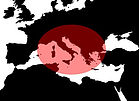Amphisbaena
December 25, 2016

A particularly odd monster, the Amphisbaena is a two-headed reptilian beast most often depicted as a dragon with a head growing out of the tip of its tail. The origin of the myth, however, speaks of a double-headed snake, both heads identical, with the ability to move both forwards and backwards to confuse its enemies. In fact, the word amphisbaena comes from the Greek words amphis (both ways) and bainein (to move), making reference to the main ability of this beast.

The study of depictions of this creatures shows that the transformation of the Amphisbaena from the two-headed snake from the Greek myths, into a two-headed dragon-type creature, occurred during Medieval times, when the Amphisbaena became a formidable monster, often found in churches’ carvings and paints, as a punisher for the wicked.
From the ancient Greek myth, we know that the Amphisbaena was born from the blood that dripped from Medusa’s severed head as Perseus flew carrying it over the Libyan Desert. Therefore, the Amphisbaena feels at home in arid lands, and it’s not picky about sustenance, feeding off of both ants and corpses. The myth also describes it as being a deadly poisonous – understandable giving it’s origin, as Medusa's blood was also a potent poison— and explain that both its heads were identical, making it impossible to know which end was charging. Furthermore, wounds –other than bites— inflicted by the creature generally failed to heal and brought death to the person who had been hurt. It was believed that the original Amphisbaena had many descendents, all of them with two heads but smaller and less poisonous than the original monster.
It was Marcus Annaeus Lucanus, a roman poet commonly referred as Lucan, who in his book Pharsalia described the Amphisbaena as a winged reptile with an extra head on the end of its long prehensile tail. He was the first to give winds to the two-headed snake.
From there, the Amphisbaena was generally shown with its tail curved above its back, grasping its extra head in the jaws of its normal mouth. In this position, it was able to travel by rolling along the ground like a wheel. It must have been a formidable adversary to encounter, for it possessed the legs of an eagle with claws to grip its victims, and eyes that gave forth beams of light in the darkness.
Despite its evil nature, in medieval times, the descendants of the original Amphisbaena were much sough-after for its medical properties. Expecting women would wear one of these lesser amphisbaenas –if they could catch one, of course— alive around their necks to assure themselves a safe pregnancy. If the meat of these serpents was ingested, one would become irresistible to the opposite sex, and killing one during a full moon would give power to the pure of mind and heart. According to the Roman writer Pliny, the skin of the amphisbaena was a remedy for cold shivers.
References:
-Matthews, J., Matthews, C. 2005. The Element Encyclopedia of Magical Creatures. Barnes & Noble Publishing, Inc.: New York,
-Rose, C. 2000. Giants, Monsters & Dragons: An Encyclopedia of Folklore, Legend, and Myth. W. W. Norton & Company: New York.
-Sedgwick, P. 1974. Mythological Creatures: A Pictoral Dictionary. Holt, Rinehart and Winston: New York.
-Hunt, Jo. 1998. Bestiary: An Illuminated Alphabet of Medieval Beasts, Hong Kong: Simon & Schuster.









